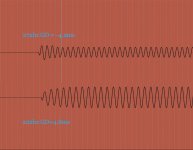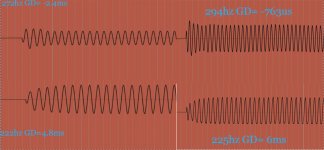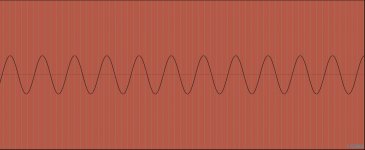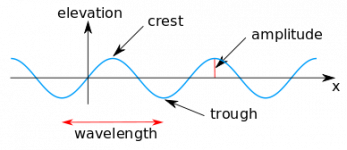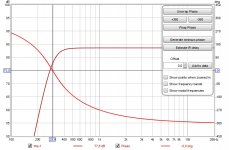Camplo, the 'pee in the lake' saying i borrowed from a well known soundman was a poor choice. The saying is more related to 'how significant something is', than to 'how relevant something is'....my bad.
I do think group delay is significant, i just don't find it to be relevant.
Because the simpler concept of phase is the prime factor in understanding group delay....and more importantly is the prime factor than can actually be worked with to reduce group delay.
I share your philosophy of trying to make steps toward perfection. Indeed, like your frames-per second-example for vision, i think advances in speaker design with better phase performance (hence less group delay) will change some of our accepted wisdom about the threshold of phase audibility.
I focus on flat phase as a step towards perfection, because ime it not only solves group delay issues, but also takes care of relative transient and dynamic timings, helps keep correct timbre, improves clarity, and so far has helped reduce off-axis lobing in all of my builds.
So i see group delay as one of the symptoms of the disease (phase distortion), not as something to focus on by itself. For me, it's pure babble compared to looking straight at phase ....
I do think group delay is significant, i just don't find it to be relevant.
Because the simpler concept of phase is the prime factor in understanding group delay....and more importantly is the prime factor than can actually be worked with to reduce group delay.
I share your philosophy of trying to make steps toward perfection. Indeed, like your frames-per second-example for vision, i think advances in speaker design with better phase performance (hence less group delay) will change some of our accepted wisdom about the threshold of phase audibility.
I focus on flat phase as a step towards perfection, because ime it not only solves group delay issues, but also takes care of relative transient and dynamic timings, helps keep correct timbre, improves clarity, and so far has helped reduce off-axis lobing in all of my builds.
So i see group delay as one of the symptoms of the disease (phase distortion), not as something to focus on by itself. For me, it's pure babble compared to looking straight at phase ....
I think we are all a bunch of science nerds how about that lol
I would look at the examples I am showing and see if it give some clarity of what group delay may be.
Remember the signal being sent is (should be) perfect in amplitude...showing no variance from peak to trough...I've been in sound design long enough to know that for lack of a better phrase....**** happens....and you get stuff in your signal upstream/downstream that could be missed (windows os audio, software programming, etc etc) but we are operating on the premise that we can trust our eyes at this point.
I am using REW for tone burst, my measuring mic, and Ableton for recording...
I do not visually sample the initial tone burst but several burst in I'll grab a visual.

Here we see the same type of trend in the signals attack characteristics as with the horn, but pressure does not correlate as closely. I would have to normalize some things to see for sure. Either way, group delay seems to have the same trend on the initial signal
The visuals in the previous thread were of the Axi on the 350hz horn....
The visuals in this post are of a 4" vented midrange. Vent tuning is at 70hz iirc
I would look at the examples I am showing and see if it give some clarity of what group delay may be.
Remember the signal being sent is (should be) perfect in amplitude...showing no variance from peak to trough...I've been in sound design long enough to know that for lack of a better phrase....**** happens....and you get stuff in your signal upstream/downstream that could be missed (windows os audio, software programming, etc etc) but we are operating on the premise that we can trust our eyes at this point.
I am using REW for tone burst, my measuring mic, and Ableton for recording...
I do not visually sample the initial tone burst but several burst in I'll grab a visual.
Here we see the same type of trend in the signals attack characteristics as with the horn, but pressure does not correlate as closely. I would have to normalize some things to see for sure. Either way, group delay seems to have the same trend on the initial signal
The visuals in the previous thread were of the Axi on the 350hz horn....
The visuals in this post are of a 4" vented midrange. Vent tuning is at 70hz iirc
Attachments
And let the HD be gone. Irrespectively that some here has "given up" on it and declared it "no problem", I'm quite sure that once you have a true low distorsion speaker system you will appreciate it immensely. Measurement is the way forward to reach the goals - "by ear" is destined to fail. But I think you are on the wrong track on GD...
//
//
The measurements I've shown investigating GD are interesting. I don't know what track you think I'm on. I see trends....and the trend is showing compression on the amplitude of the beginning of the signal where ever group delay is in excess. The areas where group delay or the on the opposite of the spectrum, Amplitude is overshooting at the beginning of signal.Measurement is the way forward to reach the goals
Not my opinion, just what the data is showing.
(GD on the 272hz example above should be -2.42ms)
What's frustrating is that I 've been going on about this GD thing for a while and a constant feedback has been that I am mistaken/incorrect, GD is just a derivative of phase....has no merit to time based distortion, you name it, I've heard it....General consensus is that GD means nothing at all..
I've theorized myself all the way to this point, and now the visualization of the pressure waves coming from the diaphragm are in agreement with a good amount of the theory I have suggested...The amplitude, overtime, is directly connected to the group delay figure, no less than what time to peak energy suggest, which also seems to follow the trend line of Group Delay. More information that I did not predict involving distortion of the waveform, seems to be related to pressure and GD within the horn. Its not like I am selling this as rock solid evidence, I have learned many times that in engineering, correlation does not equal causation. Its just interesting and deserves more investigation...
Realistic in application we can use this type of literal analysis to decide whether or not to allow an area of response into the passband of a driver....using things like pressure and group delay and help feel our way through the dark.
Anyone can take measurements like I have, and come to their own conclusions.
It is my personal opinion that the attack characteristics of the signal will have a direct effect on the "texture" of sounds created at the initial entry into the listening experience. Transient material as some call it. I don't think I've said anything unknown to people...in the know.
Ignore it at your own risk....If you can't hear it, is it really that important? Not everyone can clap on beat either....maybe throw the concept of rhythm in the trash also lol.
Last edited:
Hi camplo, I have enjoyed this thread immensely. The thing is that causality does not imply causation, you need to form a precise formal statement to prove your point to the learned and very generous contributors to your thread. Theorizing is one thing, forming a theorem is quite another level of undertaking and at this point in the discussion I think that's a reasonable demand to make on you in order to make an argument that counters established science.
Last edited:
I can't find fault with what you've said and my ability and resources to investigate and give full validity to the ideas expressed here are limited.a reasonable demand to make on you in order to make an argument that counters established science
The one thing that I think it is safe to apply within a design is to investigate the attack and decay characteristics of tone burst through out the response. This leaves only "what is there", and leaves out the, "why its there", which is a lot safer than the technicalities and sophistications of why...
Also, show me a text book that says that Group Delay has nothing to do with the amplitude vs time of a signal. I personally don't know what established science says regarding Group Delay. The smartest person in the room hasn't even studied this topic. Everyone else has just repeated information to which they do not understand fully. I (mark100) have provided research from credible people that show GD affects amplitude vs time....its like people read the stuff but can't grasp it? Where do I go to find what "established science" has to say? And it has to be acoustical science I'd imagine since everyone seems to want to use the electrical definition of group delay.
Highly appreciated!!! I put a lot of time in trying to generate discussion that will lead to something relevant. For a lot of us, this is good exercise and release. In particular, if your day to day routine is lacking some intellectual stimulation.Hi camplo, I have enjoyed this thread immensely.
Last edited:
Great! Ok, so now you have a statement. All you need now is to proof it and go through possible contradictions to make your point.
Plse note, I'm not refuting you. If you're on to something it'll benefit us all.
There is a mathematical way of calculating GD as expressed in f.i. REW and VCAD, that's what I mean by 'established science'.
I have found that sims and measurements correlate really well with these and subjective listening as well. However the acoustic center of CD:s in horns is still an elusive subject to me and that has a direct bearing to this discussion.
Plse note, I'm not refuting you. If you're on to something it'll benefit us all.
There is a mathematical way of calculating GD as expressed in f.i. REW and VCAD, that's what I mean by 'established science'.
I have found that sims and measurements correlate really well with these and subjective listening as well. However the acoustic center of CD:s in horns is still an elusive subject to me and that has a direct bearing to this discussion.
Last edited:
Ok I edited my original post to suit your edits but now your response has lost context.
My argument; Group Delay has a connection to time to peak energy, and results in a distortion of amplitude vs time at the beginning of the signal. Perfect phase is 0 and likely perfect Group Delay is 0 as well.
Someone here will likely have a possible contradictory scenario to which I can use my method of analysis to investigate and see if the trend holds true.
My argument; Group Delay has a connection to time to peak energy, and results in a distortion of amplitude vs time at the beginning of the signal. Perfect phase is 0 and likely perfect Group Delay is 0 as well.
Group intelligence for the win.go through possible contradictions
Someone here will likely have a possible contradictory scenario to which I can use my method of analysis to investigate and see if the trend holds true.
Last edited:
I forgot my newly discovered issue of response through the high pressure areas nearing cutoff....The troughs are misshapen, as I put it, due to the line appearing tapered to the diaphragm as it moves inwards vs the expanding line the diaphragm see on outward motion....Am I the only one to discover this stuff? These are just theories as to the why but ya gotta start somewhere.
I noted those issues, but I come to a completely different conclusion than you do. Since the waves are no longer symmetric, they can no longer be a pure tone (or never were) - there must be harmonics in the new signal. That means that you either have a source that has harmonics or the system is nonlinear and creating these harmonics. GD cannot have anything to do with this issue.
I'm leaning towards this.system is nonlinear and creating these harmonic
Can "system is nonlinear" equate to this "due to the line appearing tapered to the diaphragm as it moves inwards vs the expanding line the diaphragm see on outward motion"???...
I relate(theorized) this issue to pressure not GD...as to say, Pressure is causing GD and a non linear response, in this horn in particular, nearing cutoff....where pressure is greatest, and thus the most influential.
Last edited:
Since I can derive exactly what the tone burst response will be from the impulse response and the input signal, any GD issues must also be apparent from the impulse response. In a linear system ALL information is contained in the impulse response. The fact that the initial transients of a pulse are modified by a change in the GD does not really imply anything beyond the fact that it changes the impulse response. If the GD delays only a small band of frequencies then this will appear in the impulse response as a delay in those frequencies. This is then called "excess GD" because there is no "signal" delay - all other frequencies propagate without delay. This kind of thing can be audible, we know that. But you have to look at the GD for the entire system not just one driver or another. That's because in a "good" crossover this GD would be eliminated because it would also have a corresponding frequency deviation. A flat frequency response through crossover would mean that there was no system excess group delay because it would have been corrected.
Can "system is nonlinear" equate to this "due to the line appearing tapered to the diaphragm as it moves inwards vs the expanding line the diaphragm see on outward motion"???...
Yes it could, but unlikely, as the major nonlinearities in a CD are not due to the nonlinearity of the pressure on the diaphragm. There are dozens of other more likely causes.
Makes a whole lot of sense to me except for I see no reference to a distortion of amplitude vs time which is not a phase issue.

The signal used to supply the above recording had no deviation in amplitude.

Horn left and dynamic driver on the right, I still have a trend going, regarding GD times and amplitude vs time at the beginning of the wave.
So lets put it this way, whats the connection? If this isn't GD....what do we call it what causes it and why does it seem to follow GD....but more importantly.....what do we call it!
The signal used to supply the above recording had no deviation in amplitude.
Horn left and dynamic driver on the right, I still have a trend going, regarding GD times and amplitude vs time at the beginning of the wave.
So lets put it this way, whats the connection? If this isn't GD....what do we call it what causes it and why does it seem to follow GD....but more importantly.....what do we call it!
Attachments
Last edited:
Propagation delay?....I think you said this once before. My point is that I am only wanting debate the issue of the amplitude vs time and nothing to do with phase.
As long as this aspect of amplitude vs time is supposed to be included in what you said about GD above... then we are on the same page I think.
Something is off....
Delay in the frequency (phase)
Delay in amplitude propagation (not phase)
not equal
So is GD ambiguously referring to both aspects?
If so lets stop saying that GD is just phase....cause its not, just, phase.
As long as this aspect of amplitude vs time is supposed to be included in what you said about GD above... then we are on the same page I think.
Something is off....
If the GD delays only a small band of frequencies then this will appear in the impulse response as a delay in those frequencies. This is then called "excess GD" because there is no "signal" delay - all other frequencies propagate without delay.
Delay in the frequency (phase)
Delay in amplitude propagation (not phase)
not equal
So is GD ambiguously referring to both aspects?
If so lets stop saying that GD is just phase....cause its not, just, phase.
Last edited:
Propagation delay?....I think you said this once before. My point is that I am only wanting debate the issue of the amplitude vs time and nothing to do with phase.
As long as this aspect of amplitude vs time is supposed to be included in what you said about GD above... then we are on the same page I think.
Something is off....
Delay in the frequency (phase)
Delay in amplitude propagation (not phase)
not equal
Ok, please first....
we don't want to debate anything...we want to get to understanding scientific fact.
Second,...." delay in amplitude vs time" ....amplitude of what?
What do you mean, not in your words please, give an illustrating link(s)
What I think that you are talking about is the startup transient in the pulse - the part of the system response that decays with time. Followed by the steady-state response (whose definition is self explanatory.) Yes an excess group delay would after this. Does it mean anything? Honestly I don't understand what you are trying to say.
So we are calling it "start up transient".... The start up transient, matters...thats what I am saying.
The start up transient appears to follow along with Group delay....A longer group delay results in a longer start up transient is what I think happens.
A long enough Start up transient will change the way something sounds in the terms of texture at the beginning of the event.
How do I know this? Because I've been designing signal for the last 10 years. lol
"the startup transient in the pulse - the part of the system response that decays with time. Followed by the steady-state response" - In sound design this is known as attack or the attack envelope where you would adjust what it does and how long it takes to do it. " steady-state response" in sound design would be referring to the sustain.
Questions....I am still confused.... is GD also describing the "start up transient" ? Or does there just happen to be longer startup transients where group delay is high?
The start up transient appears to follow along with Group delay....A longer group delay results in a longer start up transient is what I think happens.
A long enough Start up transient will change the way something sounds in the terms of texture at the beginning of the event.
How do I know this? Because I've been designing signal for the last 10 years. lol
"the startup transient in the pulse - the part of the system response that decays with time. Followed by the steady-state response" - In sound design this is known as attack or the attack envelope where you would adjust what it does and how long it takes to do it. " steady-state response" in sound design would be referring to the sustain.
Questions....I am still confused.... is GD also describing the "start up transient" ? Or does there just happen to be longer startup transients where group delay is high?
Last edited:
Put a 2nd or 4th order crossover at one of the higher frequency and run another tone burst there to find out.
Simple example from rephase and REW, perfect Dirac pulse with LR48 crossover, frequency and phase:

Group delay:

Do you see anything familiar? Your horn shows a rapid roll off at the frequency where you measure maximum group delay. Just show the frequency plot along with it, there's nothing special about the group delay plot, other than being another plot derived from the impulse.
Too bad I don't have the latest REW handy, with Tone burst capability, otherwise I could do what you are doing virtually. Not going to bother right now, I'm past my bed time already.
Simple example from rephase and REW, perfect Dirac pulse with LR48 crossover, frequency and phase:
Group delay:
Do you see anything familiar? Your horn shows a rapid roll off at the frequency where you measure maximum group delay. Just show the frequency plot along with it, there's nothing special about the group delay plot, other than being another plot derived from the impulse.
Too bad I don't have the latest REW handy, with Tone burst capability, otherwise I could do what you are doing virtually. Not going to bother right now, I'm past my bed time already.
Attachments
Last edited:
You are trying to relate frequency domain concepts - like GD, which is derived from the frequency curve - with time domain effects that you can see. Good luck with that as this can be very hard to do. That's why most of us prefer the frequency domain. But make no mistake everything in each domain is reflected somehow in the other - impulse response => frequency response and visa versa. So what you are trying to figure out probable can be done, but not easily, hence unless you do it, which I think that you have admitted you can't.
But then you have to figure that if no one else has taken the time to do "this" whatever it is, then it can't be very important.
But then you have to figure that if no one else has taken the time to do "this" whatever it is, then it can't be very important.
- Home
- Loudspeakers
- Multi-Way
- Is it possible to cover the whole spectrum, high SPL, low distortion with a 2-way?
